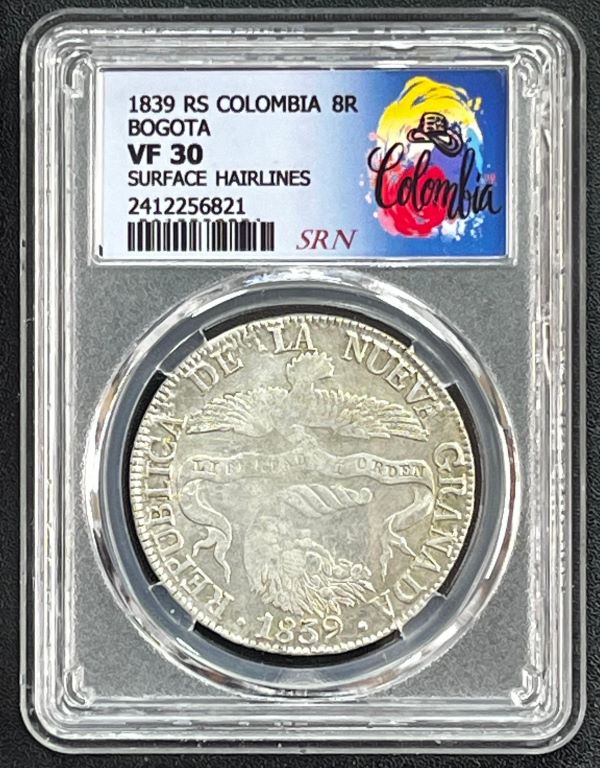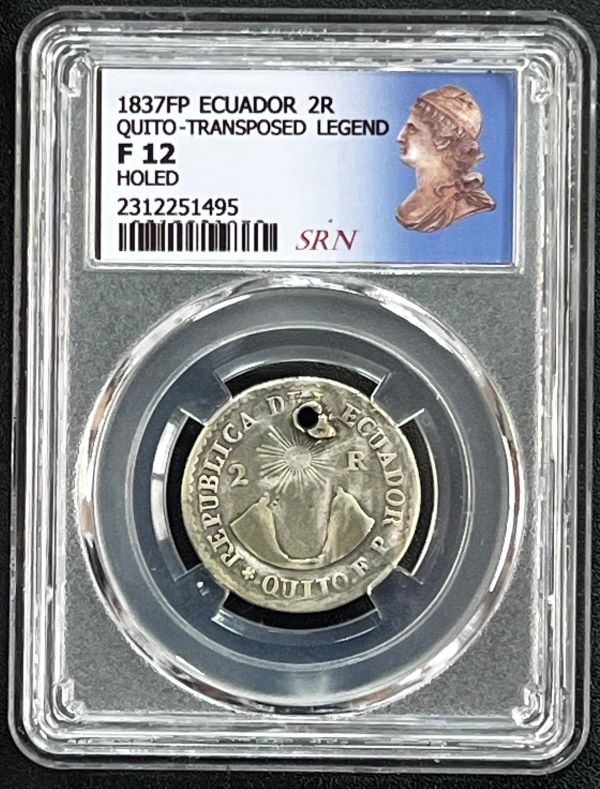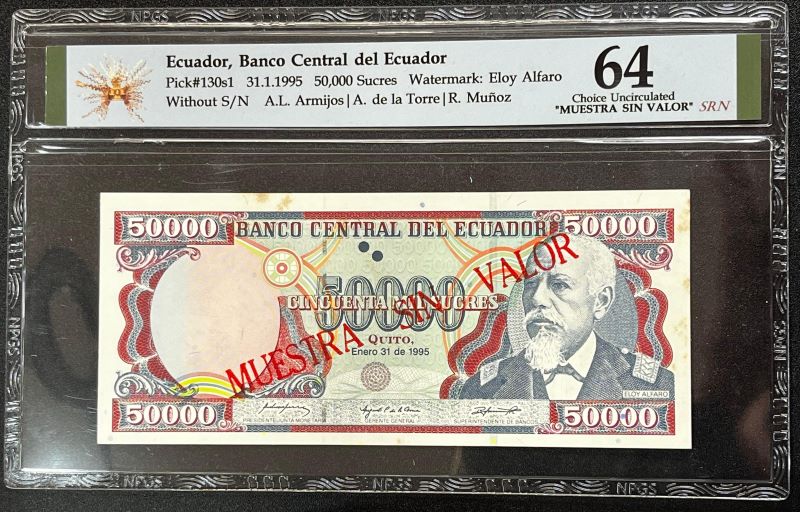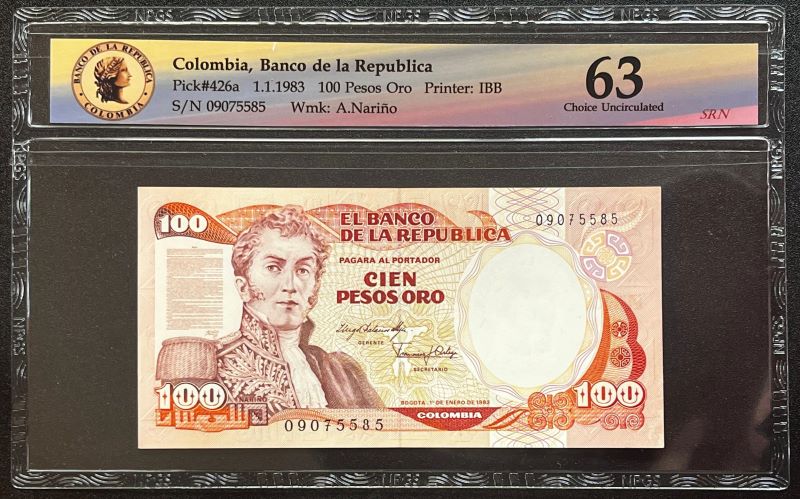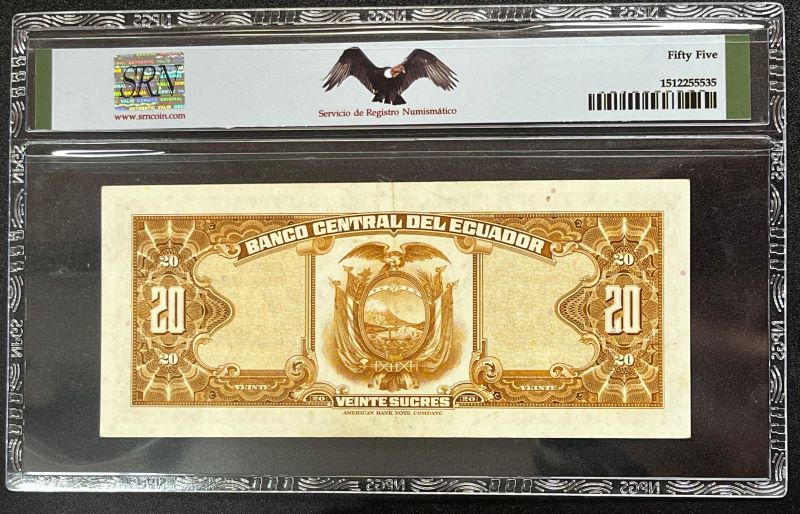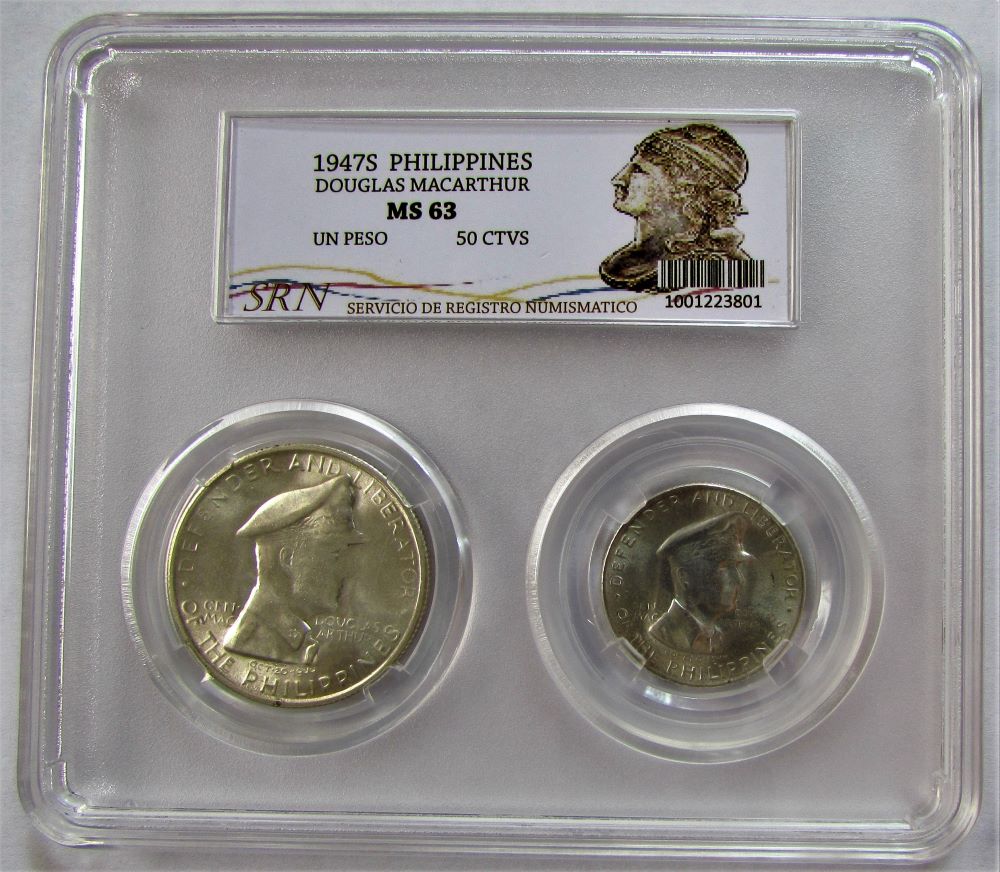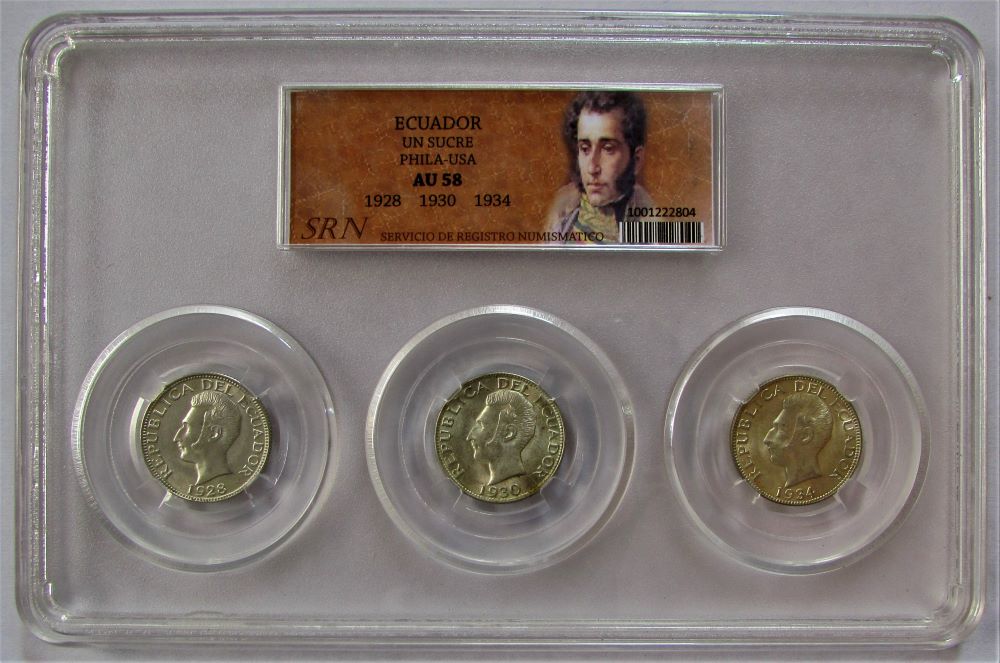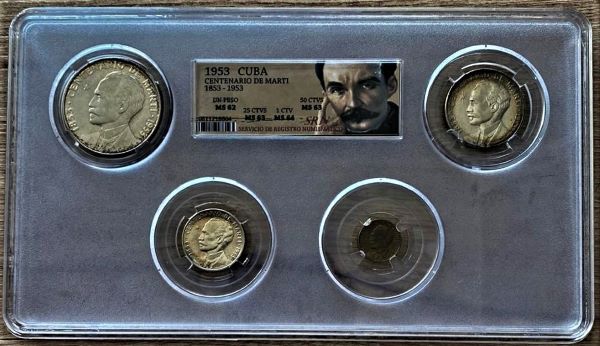Xavier Albán R. - Junio 12, 2017
| "Un Inusual Repisado" | "An Improbable Overdate" | |
| Si bien es cierto que la historia numismática ecuatoriana es corta, debido a que este comienza su propia acuñación monetaria desde el año 1833, sí cuenta con una extraordinaria variedad de piezas que la hace muy rica e interesante para los coleccionistas.
Es común encontrar dentro de un mismo año, algunas diferencias muy evidentes que hace a cada moneda especial; variedades como cambios sutiles en los diseños del escudo, errores en el texto del Listel como letras invertidas o cambiadas, acuñaciones crudas, piezas repisadas, errores de acuñación, etc. Entre las variedades de monedas repisadas, existe una gran gama de piezas con fechas repisadas que enriquece nuestro numerario. Podemos observar que, con muy escasas excepciones, la mayoría de monedas con fechas repisadas se producen en las piezas de ½, 1 y 2 décimos, que van desde los años 1891 a 1912. Es muy enigmático que la mayoría de estas monedas se produjeron solo sobre estas denominaciones, y más enigmático aún es que casi todas ellas corresponden únicamente a la ceca de Lima. Las fechas repisadas no ocurren en las cecas de Birmingham y Philadelphia, y en el caso de la ceca de Santiago de Chile, Krause World Coin reporta el repisado solo de la moneda de UN DECIMO 1889/789, que por tratarse del 8 sobre 7 en la centena de la fecha, es evidente que se trata de una corrección de error de fecha. La pieza repisada de Santiago de Chile es muy poco común, y en el Censo de la NGC reporta la existencia de una pieza solamente. |
Whilst Ecuadorian numismatic history is short, due to its having begun its own coinage only in 1833, it does have an extraordinary variety of specimens that makes it very rich and interesting for collectors.
It is common to find within a single year some very apparent differences which make each coin individual, varieties such as subtle changes in the design of the shield, errors in the legend such as inverted or altered letters, crude minting, overstrikes, minting errors etc. Amongst the varieties of overstruck coins there exists a huge range of pieces with overstruck dates which enriches our coinage. We may note that with very few exceptions most of the coins with overstruck dates are found on ½, 1 and 2 decimos pieces from 1891 to 1912. It is very puzzling that most of these coins appear only in these denominations, and even more puzzling that almost all of them relate solely to the mint of Lima. The overstruck dates do not occur in the mints of Birmingham or Philadelphia, and in the case of the mint of Santiago de Chile, Krause World Coins records an overdate only on the ONE DECIMO coin 1889/1789, which, since it relates to an 8 over 7 in the hundreds of the date, is clearly dealing with the correction of a date error. The overdated piece of Santiago de Chile is very scarce, and the NGC Census reports the existence of only one piece. |

Único décimo de Santiago de Chile 1889/789 reportada en el Censo de la NGC
The only Santiago de Chile decimo reported in the NGC Census.
|
Vale la pena mencionar, que tampoco existe registro alguno sobre la razón de porque ocurrió estos repisados en la Ceca de Lima, pero esto había sido práctica habitual en las monedas peruanas desde inicios de esa República. Se piensa que el motivo de esta práctica era para optimizar los costos de producción de los troqueles. Se hacían varios cuños para ir reusándolos en los siguientes años, por lo que era necesario corregir los dígitos de la fecha con el año en que el Ecuador solicitaba un nuevo suministro de monedas. Esta teoría es solo una hipótesis no confirmada, pues como mencioné, no existe ningún tipo de registro que aclarare este misterio, que fue muy común en la ceca de Lima, y no se encuentra otra explicación lógica que permita una segunda hipótesis. De esa manera, investigando un poco los catálogos, encontramos las siguientes producciones que fueron repisados las fechas para su uso en años siguientes:
También existen algunas piezas de ½ décimo acuñadas en la ceca de Lima, con fechas repisadas que muestran la práctica de preparar troqueles con la última o dos últimas cifras de las fechas dejadas en blanco, pero que a pesar de ello debían ser repisados por el cambio de década o siglo, de esos casos tenemos:
|
It is worth mentioning that there exists no record of why these overdates occurred in the Lima Mint, but it had been standard practice on Peruvian coins since the earliest days of the Republic. It is believed that the motive was to optimize the cost of production of the dies. It is thought that the operating cost was less if larger quantities of dies were produced, so that the excess could be used in subsequent years, for which it was necessary only to correct the digits of the date with the year in which Ecuador requested a new supply of coinage. This theory is only a hypothesis of various experienced collectors, because as already mentioned there exists no kind of record which clarifies this mystery, which was very common in the Lima mint, and there is no other logical explanation which allows a second hypothesis. In this way, by checking the catalogues, we find the following coins where the dates were overstruck for use in subsequent years:
There also exist some ½ decimo coins minted in Lima with overstruck dates which show the practice of preparing dies with the last one or two figures of the date left blank, but which still needed to be overstruck because of the change of decade or century, such as:
|

Moneda poco común de ½ décimo 1899/87 JF con corrección de repisado en la decena de la fecha.
Solo existe una pieza reportado en el CENSO de la NGC
Scarce ½ decimo 1899/87 JF with correction by decade overdate. Only one piece is recorded in the NGC CENSUS
|
Esta práctica de repisar la década y/o el siglo en los troqueles, donde el dígito o los dígitos finales fueron dejados en blanco, era práctica común en la Ceca de Lima, esto se evidencia por la existencia en la serie peruana de ½ dinero 1900/890, 1901/801, 1901/891 , 1902/802, 1902/892, 1903/803, 1903/893, 1904/894, 1905/805, como también en 1 dinero 1900/890, 1902/892, 1903/893, y en el sol. 1890/80, 1891/81, 1892 / 82 y muchas otras piezas. Debemos mencionar que no existen registrados en los Censos de la NGC y PCGS, algunas monedas como los ½ décimo 1902/892 y de 1905/2, por lo que no se tiene confirmación de la existencia de estas piezas, sin embargo, ambas monedas están reportadas en el catálogo de Krause World Coins. Además de las monedas con fecha repisada de la familia de los décimos, existen otras piezas conocidas con este mismo error, y que corresponden a las monedas pre-decimal, entre las que existen reportadas las siguientes: |
That this practice of overstriking the decade and century on dies where the final digit or digits were left blank was common practice in the Lima mint is evidenced by the existence in the Peruvian series of ½ dinero 1900/890, 1901/801, 1901/891, 1902/802, 1902/892, 1903/803, 1903/893, 1904/894, 1905/805, 1 dinero 1900/890, 1902/892, 1903/893, sol 1890/80, 1891/81, 1892/82 and many more. We should mention that there is no record in the NGC and PGC Censuses of certain coins such as the ½ decimo 1902/892 and 1905/2, so there is no confirmation of the existence of these pieces, although both coins are reported in the Krause World Coins Catalog. In addition to the overdated decimal coins, there exist other pieces known with the same type of error corresponding to the pre-decimal coinage, amongst which the following are recorded: |
|
|
|
Todas estas piezas repisadas pre-decimal, están confirmadas su existencia. También NGC menciona la posible existencia de una pieza repisada de 2 Reales 1839/8 MV, sin embargo aún no existe reporte alguno en el Censo, razón por lo que no podemos confirmar su existencia. |
All these pre-decimal overstruck pieces are confirmed to exist NGC also mentions the existence of an overstruck 2 reales 1839/8 MV, but there still exists no record in the Census so we are unable to confirm its existence. |
World Coins Price Guide Ecuador 2 Reales 1839 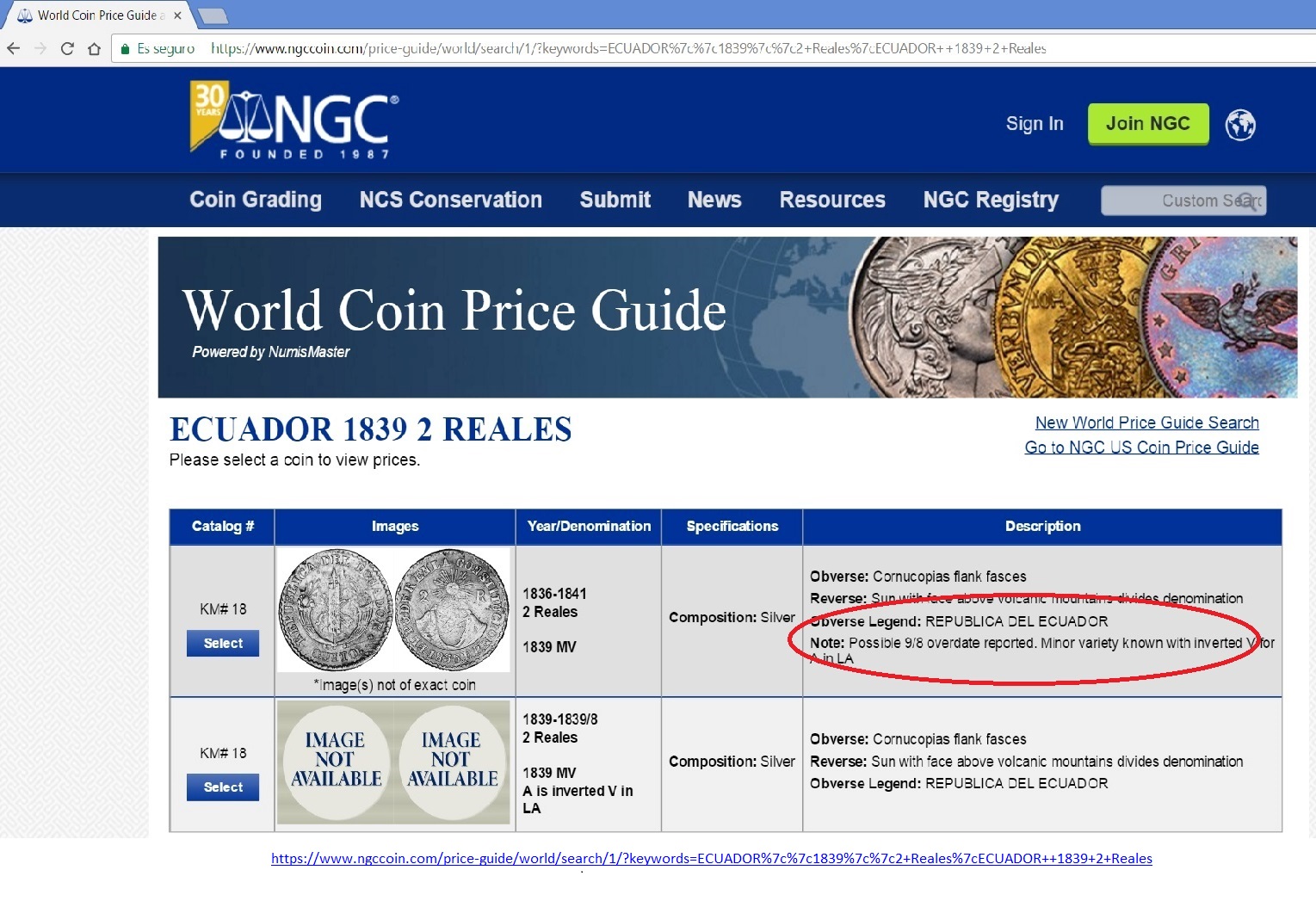
|
El misterio del 2 REALES 1834/5 GJ Lo que se debe tener presente es que todas las monedas con fechas repisadas tienen algo en común, y es que la fecha repisada normalmente está sobre un huésped de un año anterior al repisado. Sin embargo, esta regla tiene su excepción. |
The mystery of the 2 REALES 1834/5 GJ. What should be borne in mind is that all the coins with overdates have one thing in common, which is that the overstruck date is normally over a date earlier than that of the overstriking. However this rule has an exception. |

2 reales 1834/5 GJ
| En el compendio ECUADORIAN COINS – An Annotated checklist – Edition 2016 por Dale Seppa, en la pág. 18, reporta la existencia de una moneda de 2 Reales con fecha repisada 1834/5 GJ, una moneda cuyo repisado es inusual, debido a que es sobre un año adelantado al repisado impreso y no sobre un año anterior como es lo común. | Seppa’s compendium ECUADORIAN COINS – An Annotated checklist – Edition 2016 on page 18 reports the existence of a 2 Reales coin with overstruck date 1834/5 GJ, a coin whose overstriking is unusual in that the overstriking is on a future date compared to the overstriking rather than an earlier date as is normal. |

Moneda 1834/5 en la que se puede observar claramente debajo del 4 los trazos del número 5
1834/5 coin in which traces of the number 5 can clearly be seen under the 4
| En ese compendio, DALE SEPPA menciona que la moneda está certificada por la NGC como VF DETAILS con Hairlines, el mismo que fue subastado por DFS (Daniel Frank Sedwick) en Mayo del 2013 en un valor superior a los US$800. En la subasta DFS menciona que esta pieza es la única conocida hasta el momento, con un valor estimado entre US$1000 a US$2000. Se puede ver la subasta en el link: | In this compendium SEPPA mentions that the coin is certified by NGC as VF DETAILS with Hairlines, the same as was auctioned by DFS (Daniel Frank Sedwick) in May 2013 at a price in excess of US$800. In the auction DFS mentions that this piece is the only one known up till now, with a value estimated between US1000 and US$2000. The auction can be seen at the link: |
| Seppa también menciona en su compendio, que no tuvo la oportunidad de encontrar los registros y el código de verificación asignado por la NGC, para poder estudiar este inusual repisado y confirmarlo, pero es claro de que se trata de una moneda de 2 reales de 1835GJ repisada con el 4. Esto lo confirmamos fácilmente, porque la única diferencia que existe entre las monedas de 2 reales de 1834 de las de 1835, es el punto al final de la palabra CONSTITUCIÓN (todas las monedas de 1834 tienen un punto al final de la palabra mencionada, mientras que las monedas de 1835 no tienen el punto). La moneda repisada de la subasta DFS (1834/5) no tiene el punto, y así lo indica la descripción de la subasta DFS, lo que claramente confirma que se trata de una moneda 1835 repisado con el 4. | Mr. Seppa also mentions in his compendium that he had not had the opportunity to find the records and the verification code assigned by NGC, to be able to study this unusual overdate and confirm it, but it is clear that it concerns a 2 reales of 1835 GJ overstruck with a 4. This we can easily confirm because the only difference which exists between the 2 reales coins of 1834 and those of 1835 is the period at the end of the word CONSTITUCION (all the 1834 coins have a period at the end of the said word, whilst the 1835 coins do not have the period). The overstruck coin from the DFS auction (1834/5) does not have the period, as is indicated in the description from the DFS auction, which clearly confirms that it is a coin from a die of 1835 overstruck with a 4. |

Monedas de 2 Reales 1834 y 1835 donde se observa la característica principal que difiere a ambas acuñaciones, El PUNTO al final de la palabra CONSTITUCION, que solo lo tiene la acuñacion de 1834
2 Reales coins of 1834 and 1835 where can be seen the principal feature which distinguishes both coinages, the PERIOD at the end of the word CONSTITUCION, which appears only on the 1834 coinage
| La moneda de la subasta DFS llegó a mano de varios coleccionistas ecuatorianos, hasta que llegó a mis manos en marzo del 2017, junto con el soporte blanco del Slab y la etiqueta de certificación de la NGC con la que se había subastado en el 2013, pues habían extraído la moneda de su capsula. El código de verificación que tenía aquella certificación era el 2782907-001. En abril del 2017 envié nuevamente esta moneda a la NGC, para que sea revisada por los especialistas de esa certificadora por segunda vez. El resultado obtenido fue exactamente el mismo que el de la certificación anterior: Una moneda de 2 Reales 1834/5GJ con el grado VF DETAILS, con el mismo defecto de Hairlines. Esta nueva certificación tiene código de verificación 2812314-001 | The coin from the DFS auction passed through the hands of several Ecuadorian collectors until I acquired it in March 2017, together with the white holder for the Slab and the NGC certification label with which it had been auctioned in 2013, since the coin had been removed from its container. The verification code on this certification was 2782907-001. In April 2017 I sent this coin to NGC again, so that it could be reviewed by the certification experts for the second time. The result obtained was exactly the same as the previous certification. 2 reales 1834/5 GJ with the grade VF DETAILS, with the same defect of Hairlines. This new certification has the verification code 2812314-001 |

Moneda Certificada en el 2017 Soporte vacio y con la moneda certificada en el 2013
Coin certified en 2017 Empty holder and with the coin certified in 2013
NGC 2812314-001 NGC 2782907-001

2 Reales 1834/5 GJ - NGC 2812314-001 (2017) 2 Reales 1834/5 GJ - NGC 2782907-001 (2013)
Fotos de las monedas certificadas en la NGC de los años 2017 y 2013 respectivamente, que evidencia a ambas monedas como la misma pieza.
Photographs of the NGC certifications of 2017 and 2013 respectively, which shows that both coins are the same piece.
|
Es decir, 4 años después de la primera certificación, la NGC volvió a validar el mismo repisado del 4 sobre 5, con el mismo grado de calidad y registrando el defecto de Hairlines, sin que se informara a ellos de que se trataba de la misma pieza que se certificó en el 2013. Esto lo podemos confirmar con facilidad, al comparar ambos registros fotográficos de la NGC del 2013 y 2017, donde se observa hasta los mismos Hairlines debajo de la letra R en el anverso (2 rayas debajo de la R). Esto hace que nos hagamos las siguientes preguntas: Cómo sucedió este inusual repisado? Por qué el cuño de 1835 fue corregida con el 4? Primero se contactó a Dale Seppa para que revisara el repisado de la moneda, debido a que él ya había anunciado la existencia del mismo, y no había tenido la oportunidad de conseguir imágenes de la pieza en el 2013 para un análisis más minucioso. Él logró validar que el repisado de la fecha existía, y que a su criterio era genuino y propio de la acuñación original de la moneda. También inspeccionó de este particular el Sr. Michael Anderson llegando a la misma conclusión sobre el inusual repisado. Entonces, cómo se explica lo sucedido. Solo podemos formular algunas hipótesis en base a las investigaciones y afirmaciones efectuadas por los historiadores sobre algunos hechos en los periodos 1834 a 1836: 1.- Debemos tener en consideración que uno de los talladores que elaboraron los cuños en el periodo de 1834 y 1835 era el Sr. Eduardo Coronel, quien según menciona Melvin Hoyos en su obra “La Moneda Ecuatoriana a través de los tiempos” fue despedido como tallador de la Casa de Monedas por irresponsabilidades en sus labores, no se aclara qué trabajos irresponsables hizo el Sr. Coronel como para ser despedido, pero hace que nos cuestionemos si podría ser este uno de los errores irresponsables en sus labores? 2.- Melvin Hoyos también menciona en su obra, que el Sr. Eduardo Coronel fue descubierto con un cuño robado de la casa de amonedación. Según referencia de Historia Numismática de Ecuador Inédito, IZA Terán Carlos, ocurrió en marzo de 1836, y la producción en ese año se ordenó comenzar recién el 14 de Julio, de acuerdo a lo mencionado en la obra de Melvin Hoyos página 110, segunda edición. Todo esto nos permite hacer las siguientes observaciones: a.- Era imposible que el robo del cuño correspondiera a uno elaborado en 1836, debido a que la producción de monedas se ordenó en Julio de 1836 y el Sr. Eduardo Coronel fue descubierto con el cuño robado en marzo de ese mismo año. b.- Que nos permite intuir que el cuño robado debió ser del año 1835 o anterior, que eran los que existían hasta antes de ser descubierto el Sr. Coronel, pero es muy probable que hubiera tomado uno de los más disponibles en el momento, lo que podría ser uno de 1835, para usarlo en sus ilícitas labores entre 1835 y/o 1836 hasta ser descubierto. c.- Por la referencia de Historia Numismática de Ecuador Inédito, IZA Terán Carlos, se menciona que el Sr. Coronel realizaba los trabajos de falsificación en la misma casa de amonedación en donde fue descubierto con un cuño robado en marzo de 1836. d.- A inicios de la República, los falsificadores robaban parte de la plata de las monedas de buena ley, haciendo acuñaciones fraudulentas de baja ley, y así obtener rédito con el metal que obtenían.
Considerando estas observaciones, nos permite plantear algunas hipótesis, como la posibilidad de que el cuño robado probablemente fue del año 1835, y pudo haber sido adulterado la fecha por el Sr. Coronel con la del año anterior (1834/5), con la finalidad de poder incorporar sus piezas de mala ley, realizados en la misma casa de amonedación, muy probablemente desde 1835 a inicios de 1836, tratando de ocultarlas entre las monedas de un año en la que ya existía un numerario completo en circulación; para ello hay que recordar que la acuñación de 1835 comenzó en marzo y duró hasta diciembre, razón por lo que el numerario de 1835 al inicio no debió existir las suficientes piezas como para pasar desapercibido sus monedas ilegales. Otra hipótesis puede ser que lo hizo para evitar los controles de calidad de las piezas acuñadas en 1835, al ser marcadas como 1834 estaría exento del control si la moneda no era parte de la producción vigente en el momento. O también pudo haber corregido el cuño simplemente para no tener en su poder un cuño del año en que se hacía una producción. Pero cualquiera de estas hipótesis estaría sujetas a que la pieza en mención sería una pieza adulterada de la época, acuñada en la misma casa de monedas, y que la pieza debería contener poca o ninguna plata; esto habría sido detectado por la NGC o por las personas que revisaron esta moneda, porque cualquier coleccionista con algo de experiencia podía ver que esta pieza es de buena plata. Por otra parte, también es posible que el cuño corregido pudiera haber golpeado, en buena plata, una o varias piezas después de que este fuera recuperado cuando descubrieron al Sr. Coronel, ya sea para el registro o simplemente por error. 3.- La tercera hipótesis se basa en una simple pregunta: ¿Qué hecho relevante se dio en 1835 que pudo afectar la concepción de las monedas de ese año? El 13 de agosto de 1835 se promulgó la 2da Constitución del Ecuador eliminándose la idea de la confederación con Colombia y se cambia el nombre “Estado del Ecuador en la República de Colombia” (en las monedas se abrevia como “El Ecuador en Colombia”) por “República del Ecuador”. Entonces corresponde averiguar en qué meses se elaboraron los 2 reales de 1835, ya que si todo o parte de los mismos se hicieron luego del 13 de agosto, existe razón para pensar que su año pudo haber sido corregido intencionalmente para que su diseño no contraríe lo que establecía la nueva Constitución. En tal caso sería más fácil corregir el último dígito del año que el nombre de la Nación. Si esta hipótesis fuera cierta, este rarísimo ejemplar evidenciaría la intención de evitar que el monetario producido en 1835 incumpla lo establecido por la Constitución sancionada el 13 de agosto de ese año. Quizás hubo la intención de corregir el año, se probó la viabilidad en unas pocas piezas y al final se resolvió no realizar la corrección quedándonos este ejemplar que se convertiría en un testigo de los cambios políticos y constitucionales del país. Este suceso, del cambio de nombre a República del Ecuador, coincide con el año preciso de elaboración de esta moneda repisada. Probablemente nunca sabremos la real causa de porque se hizo ni cómo, pero lo que sí es seguro es que la pieza cuenta con este inusual detalle, que fue verificado por la NGC en dos ocasiones (en el 2013 y 2017). Además fue revisado por personas con mucha experiencia en monedas coloniales y pre-decimales, como Daniel Frank Sedwic, cuando presentó esta pieza en su casa de subasta en el 2013, calificándola como única conocida hasta el momento, y los señores Dale Seppa y Michael Anderson quienes tuvieron la oportunidad de estudiar este inusual repisado. Definitivamente debe tratarse de una moneda muy poco común. Si algún coleccionista tiene alguna pieza con este tipo de repisado (1834/5), repórtelo (incluir fotos) a This email address is being protected from spambots. You need JavaScript enabled to view it. para registrar su existencia. |
That is to say that four years after the first certification NGC again validated the same overdate of 4 over 5, with the same grade of condition and recording the defect of Hairlines, without being informed that it involved the same piece that had been certified in 2013. This we can easily confirm by comparing both NGC photographic records of 2013 and 2017, where can be seen even the same Hairlines below the letter R on the obverse (2 marks below the R). This causes us to ask the following questions: How did this improbable overdate happen? Why was a die of 1835 corrected with a 4? First Mr. Dale Seppa was contacted so that he could review the overstrike, since he had already announced its existence and had not had the opportunity to obtain photographs in 2013 for a more detailed examination. He succeeded in confirming that the overdate existed, and that in his opinion it was genuine and an authentic original mintage of the coin. Mr. Michael Anderson also checked this aspect, arriving at the same conclusion about the improbable overdate. So, how do we explain what happened? We can only offer some hypotheses based on the research and conclusions reached by historians about the events of the period 1834 to 1836: 1. – We must take into account that one of the engravers who prepared dies in the period of 1834 and 1835 was Mr. Eduardo Coronel, who, according to Melvin Hoyos in his “La Moneda Ecuatoriana a través de los tiempos”, was dismissed as mint engraver for irresponsibility in his duties. It is not explained what irresponsible duties Mr. Coronel committed to be dismissed, but we must wonder if this could have been one of the irresponsible errors in his duties. 2. – Melvin Hoyos also mentions in his work that Mr. Eduardo Coronel was found with a die stolen from the mint. This, according to the unpublished Numismatic History of Ecuador of IZA Terán Carlos, occurred in March 1836, and production in this year was ordered to begin only on 14 June, according to what is said in Melvin Hoyos’ book, second edition, page 110. All this allows us to make the following observations: a.- It is impossible that the theft of the die related to one produced in 1836, since the minting of coins was ordered in June 1836 and Mr. Eduardo Coronel was found with the stolen die in March of that year.. b.- We can infer that the stolen die must have been of the year 1835 or earlier, which were those which existed before Mr. Coronel was found out, but it is very probable that he would have taken one of those most readily available at the time, which would have to be one of 1835, to be used in his criminal activity in 1835 and/or 1836 until being found out. c.- According to the unpublished Numismatic History of Ecuador of IZA Terán Carlos, it is said that Mr. Coronel carried out his forgeries in the same mint where he was found with a stolen die in March 1836.. d.- In the early days of the Republic, forgers used to steal part of the silver from coins of good fineness, making fraudulent coinages of base fineness, and thus making a profit from the metal they obtained.
Considering these observations, we can develop certain hypotheses, such as the possibility that the stolen die was probably of the year 1835, and the date could have been altered by Mr. Coronel to that of the previous year (1834/5) with the objective of being able to incorporate his base pieces, produced in the same mint, very probably from 1835 to early 1836, trying to hide them among coins of a year of which there already existed a complete supply in circulation; for which it is necessary to remember that the 1835 mintage began in March and lasted until December, so that at the beginning not enough of the 1835 coinage could have existed to conceal the false coins. Another hypothesis could be that he did it to avoid the quality controls of coins minted in 1835, being dated as 1834 they would be exempt from control if the coinage was not part of the production current at the time. Or he could have changed the die simply so as not to have in his possession a die of a year currently in production. But any of these hypotheses would require that the piece under consideration would be an adulterated coin of the time, coined in the mint itself, and that the piece would have to contain little or almost no silver. This would have been detected by NGC or by any of the persons who reviewed this coin; furthermore collectors with any experience could see that the coin is of good silver. Alternatively the mint could have struck this piece in good silver after the die was recovered from Mr. Coronel, either for the record or simply by mistake. 3.- The third hypothesis is based on a simple question: What relevant fact occurred in 1835 which could affect the design of that tears coins? On 13 August 1835 the second Ecuadorian Constitution was promulgated, abolishing the idea of the confederation with Colombia and changing the name “State of Ecuador in the Republic of Colombia” (abbreviated on the coins as “El Ecuador en Colombia”) to “República del Ecuador”). Therefore it is necessary to ascertain in which months the 1835 2 reales were produced, since if all or part of them were made after 13 August there is reason to think that the date could have been corrected intentionally so that the design did not contradict what had been established by the new Constitution. In such a case it would be easier to correct the date than the name of the country. If this hypothesis were correct, this extremely rare specimen would indicate the intention to avoid the 1835 coinage being inconsistent with what had been approved by the Constitution on 13 August of that year. Perhaps having had the intention of correcting the date, they tested the viability of a few specimens and in the end decided not to make the correction, leaving us this example which would become a witness to the political and constitutional changes in the country. This event, the change of name to República del Ecuador, coincides with the exact year of the manufacture of this overstruck coin. Probably we shall never know the real reason why and how it was done, but what is certain is that the piece has this unusual detail, which was verified by NGC on two occasions (in 2013 and 2017). Furthermore it was reviewed by persons with much experience of colonial and pre-decimal coins, such as Daniel Frank Sedwick, when he offered this piece in his auction house in 2013, describing it as the only one known up to that time, and Messrs. Dale Seppa and Michael Anderson, who had the opportunity to study this improbable overstrike. Definitely it must be a very scarce coin. If any collector has a specimen with this type of overstrike (1834/5), report it (with photographs) to This email address is being protected from spambots. You need JavaScript enabled to view it.to record its existence and be considered in future article. |

